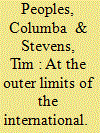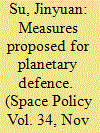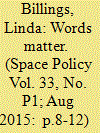|
|
|
Sort Order |
|
|
|
Items / Page
|
|
|
|
|
|
|
| Srl | Item |
| 1 |
ID:
175554


|
|
|
|
|
| Summary/Abstract |
As staples of science fiction, space technologies, much like outer space itself, have often been regarded as being ‘out there’ objects of international security analysis. However, as a growing subset of security scholarship indicates, terrestrial politics and practices are ever more dependent on space technologies and systems. Existing scholarship in ‘astropolitics’ and ‘critical astropolitics’ has tended to concentrate on how such technologies and systems underpin and impact the dynamics of military security, but this article makes the case for wider consideration of ‘orbital infrastructures’ as crucial to conceptions and governance of planetary security in the context of the ‘Anthropocene’. It does so by outlining and analysing in detail Earth Observation (EO) and Near-Earth Object (NEO) detection systems as exemplary cases of technological infrastructures for ‘looking in’ on and ‘looking out’ for forms of planetary insecurity. Drawing on and extending recent theorisations of technopolitics and of Large Technical Systems, we argue that EO and NEO technologies illustrate, in distinct ways, the extent to which orbital infrastructures should be considered not only part of the fabric of contemporary international security but as particularly significant within and even emblematic of the technopolitics of planetary (in)security.
|
|
|
|
|
|
|
|
|
|
|
|
|
|
|
|
| 2 |
ID:
142583


|
|
|
|
|
| Summary/Abstract |
Whereas the Earth is showered by extraterrestrial matters on a constant basis, most of them cannot survive the very high heat produced in their entry into the atmosphere to make a terrestrial impact. Impacts that are capable of inflicting terrestrial casualties and damages are even rarer. However, their consequences can be high, and even so nowadays with the change of human settlement patterns on the Earth. With the development of space science and technology, human beings are now capable of predicting possible impacts with some accuracy, and even minimizing the chance of actual collision. For the later purpose, many proposals have been put forward, which either employ weapons readily found on the Earth, or envisage newly developed technologies that could nevertheless be used for military purposes. This short note applies existent international law to these measures, and attempts to shed some light on their implications for ongoing discussions of space arms control.
|
|
|
|
|
|
|
|
|
|
|
|
|
|
|
|
| 3 |
ID:
142578


|
|
|
|
|
| Summary/Abstract |
The global community of scientists involved in finding and tracking near-Earth asteroids (NEOs), identifying potentially hazardous NEOs, and characterizing the possible effects of asteroid impacts with Earth is developing an awareness of the need to improve and expand efforts to communicate with policy and decision makers about the work they do.
This paper addresses the criticality of clear, concise, correct communications about asteroid impact risks and hazards, as well as proper distinctions among risks, hazards, and actual threats. It reviews recent progress in communication about NEO hazards and impact risks, including new recommendations from expert groups, guidelines for responsible communication about hazards and risks, communication issues raised in collaborations with disaster planners, and other relevant developments.
The next significant asteroid impact with Earth could be 500 years from now, or next week. The need to be prepared for such an event is clear. Policy and decision makers will depend on the community of experts involved in NEO observations and planning for planetary defense for information on the risks and hazards of asteroid impacts with Earth.
|
|
|
|
|
|
|
|
|
|
|
|
|
|
|
|
|
|
|
|
|